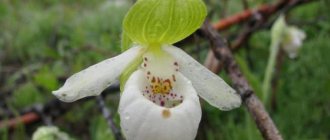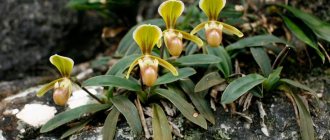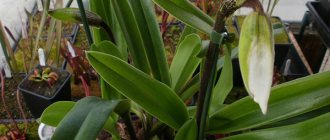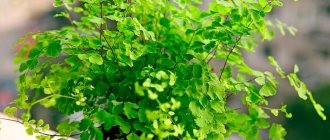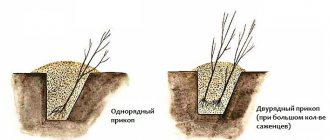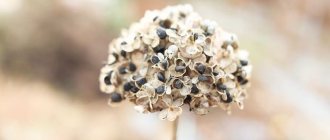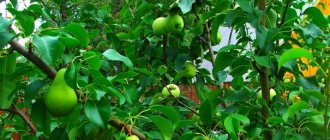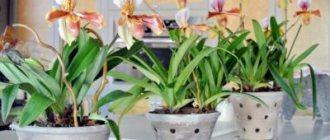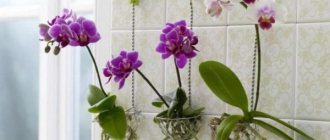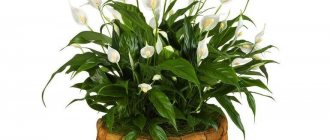How to draw a lady's slipper step by step with a pencil
Paphioledilum or lady's slipper belongs to one of the orchid family. The unusual and sophisticated appearance of this flower cannot fail to attract attention. The inflorescence is like a fancy tiny shoe with a sail-shaped sepal. The variegated leaves shimmer velvety in the sun, emphasizing the sophistication of paphioledilum.
Lady's slipper
Despite its fragility, the flower has adapted well to home cultivation and blooms almost all year round.
Origin
The plant lives in the natural conditions of tropical and subtropical forests in India, America, China, Malaysia, and the Philippines. About 80 biological species have been identified. Paphiopedilum prefers old hollows, damp areas under trees, stumps, and fallen ruins of trunks.
Homeland of the Slipper of Venus
Certain orchid species grow well in deciduous and coniferous forests of Siberia, the Volga region and the Far East.
In each country the plant has its own name. For example, on the American continent - moccasins, in European countries - a lady's slipper and a lady's shoe, in the vastness of Russia - boots, cuckoo shoes, boots of the Virgin, Adam's head.
Description
All representatives of orchids are classified as herbaceous, beautifully flowering perennials. The color of the leaf blade is dark green or marble gray. The leaves grow up to 30 cm. The rosette forms a single peduncle.
Racemose inflorescences are located on a high peduncle of 40 cm. Individual flowers are rare. In some paphiopedilums, a new bud appears instead of the old one, which significantly prolongs flowering.
The most common are striped and spotted flowers of the lady's slipper, but there is a wide variety of colors: white, yellow-brown and purple, even green, which is confirmed by the photo.
Varieties of paphiopedilums with uniformly colored leaves form flowers by the end of winter, while variegated ones bloom in the autumn-summer period.
The flower is formed by the petals of the corolla from two tiers. The side petals are narrow and slightly twisted and directed to the sides, like wings. The lower petal forms a sac-like lip or shoe of bright colors to attract insects. After pollination, a fruit appears with many dust-like seeds.
Paphiopedilum
To live, they choose the trunks of large trees under the rays of the sun, to which they are attached as a support. Nutrients are obtained from the environment and do not harm the trees at all.
The thick and short rhizome of the lady's slipper spreads in the upper soil layer. Before the appearance of a young sprout, 3-4 years of secretive development of the bud take place. The root performs a fastening or feeding function. Depending on the purpose they differ in color: dark brown and light hairy with a sinuous structure. For nutrition, they absorb water containing organic impurities from cracks in the bark.
Common varieties of indoor paphiopedilum
Home care – we reproduce natural conditions
Temperature and lighting
Lady's slipper prefers warm conditions. It requires seasonal temperature control. In winter, the growing temperature is 18-24°, in the warm summer months 23-27°.
The plant is accustomed to daily temperature changes. The daytime temperature should differ from the nighttime temperature by 5 degrees. At night in summer the room is ventilated.
You need to place the plant on a sunny windowsill. On a hot afternoon, the paphioledilum is shaded. In winter, the plant must be illuminated up to 12 hours of daylight. During the summer months, lady's slipper will do well in the garden outdoors.
Phragmipedium
Watering and fertilizing
The watering regime does not differ throughout the year. Before watering, the water is left to sit for a day or used filtered and heated to 30°. Pour into the pot from a thin spout to prevent it from getting on the leaves. In case of accidental contact, remove water with a napkin. Excess moisture can cause rot. Therefore, immersion irrigation is more often used. The pot with the plant is placed in a container of water. The nutrient mixture in which the plant is planted, made from peat with small parts of tree bark, takes 15-20 minutes to soak. If coarser bark fragments are used, they will be saturated in 40-60 minutes.
After watering, the remaining water is removed from the pan. It is recommended to carry out the next watering after the soil has dried. In winter, when flowering has ended, you should water and spray less.
The plant's homeland is humid forest. It is important to ensure air humidity near the paphioledilum. Regular spraying of water or lining the bottom of the tray with expanded clay and moss, which retain moisture, is suitable.
For feeding, it is better to purchase ready-made fertilizer for orchids. The frequency of application is once a month. During the flowering period, the rate is doubled.
The application of organic fertilizers promotes the decomposition of the substrate, so it is rarely used.
Selenipedum
Transplanting a plant
The timing of replanting paphioledilum is determined by the condition of the plant and soil. Depressed appearance, signs of rot and mold with a corresponding smell. Compaction of the substrate indicates the need to replant the plant.
It is considered normal to replant the plant every 2 years. The procedure is planned for the end of flowering. This way the plant will take root better.
The full development and flowering of the lady's slipper depends on the correct preparation of the nutrient mixture. When preparing it yourself, mix 0.5 kg of crushed conifer bark, 100 g of charcoal and peat, add 50 g of shell powder and perlite.
If it is not possible to select all the components, then purchase a ready-made soil mixture for orchids.
The pot for planting is chosen to be wide at the top, tapering at the base, and of small height. This shape of the container will prevent damage to the roots during the next transplant. The bottom of the container is covered with drainage, then the substrate is laid out. At the time of transplantation, the plant should be dry; watering should be stopped several days before. When replanting, inspect the roots of the plant and remove damaged areas with a sharp blade. The sections are treated with activated carbon powder. The first watering is carried out after 3 days.
Read also How to build a garden toilet
Lady's slipper grandiflora
How does it reproduce
Paphiopedilum can be propagated by dividing the bush. Rosettes with at least two formed leaves and the presence of roots must be planted. In this case, the orchid takes root more easily and flowering will begin faster.
With good care, the lady's slipper will delight you with long flowering and will decorate your apartment.
Watch also the video on the topic:
Diseases and pests
Of the pathogens, fungi pose a risk, especially at the growth stage of shoots and leaves. Signs of damage are deformation of sprouts, the appearance of brown and brown spots. Diseased flowers are isolated and damaged parts are removed. Treated with fungicides - Trichodermin, Bactofid.
For spraying plants use:
- Topaz;
- Quadris;
- Ridomil;
- Allett;
- Speed
Plants can be harmed by:
- Slugs;
- Chervets;
- Snails;
- Ticks;
- Aphid;
- Scale insects.
To combat insects, bushes are irrigated with Aktofit, Iskra, Aktara, Aktellik, and Confidor. In the initial stages, garlic and ash solutions are effective.
For many gardeners, the exquisitely beautiful Lady's slipper has become a garden classic. If you create comfortable conditions, the flowers look great in flower beds, greenhouses, and mono-plantings. Shoes bring natural beauty to the interior and relaxation areas. For cultivation it will be necessary to create conditions reminiscent of the natural environment.
Currently reading:
- How to grow Chinese cabbage in open ground
- Using hydrogel in open ground for plants
- Persistent, large harvest of cucumbers after planting them as seedlings
- Increased potato yield using Dutch technology
Popular: Growing, care and beneficial properties of the chistets plant (stachys)
Share the news on social networks
About the author: Vladimir Petrovich Efremov
Chief agronomist of the limited liability company “Association of Peasant (Farm) Farms “Kuznetsovskaya””, Ilovlinsky district of the Volgograd region.
Add a comment Cancel reply
You must be logged in to post a comment.
Lady's slipper is a perennial evergreen plant with leaves of green, dark green or grayish-marble color up to 30 cm long. Each rosette of leaves produces one peduncle up to 40 cm tall, which can be single-flowered or multi-flowered. The flowers are from 7 to 12 cm in diameter, with a wide variety of colors: from white, purple and yellow to brown and green, spotted or striped flowers are often found.
The Legend of Venus's Slipper
In ancient Greek mythology there is a legend about the slipper of Venus, or more precisely about the slippers of Venus, which turned into a beautiful flower.
A thunderstorm caught Venus and Adonis while hunting; they hid from the rain in a secluded, quiet place and indulged in lovemaking. A man passing by did not notice Venus with her lover, but saw her shoe made of pure gold abandoned on the ground. And as soon as the commoner stretched out his hand to pick up the shoe, it instantly turned into a flower resembling a shoe.
Legends about the slipper of the goddess Venus
According to legend, the owner of these unusual shoes is considered to be the Greek goddess of beauty and love Cyprida, also known as Aphrodite or Venus.
The name of the flower comes from fairy tales and legends, and the flower, with its unusual shape, reminiscent of a woman’s silk slipper, appeared on earth thanks to the sweet forgetfulness and absent-mindedness of the goddess Venus.
According to one legend, lovers Venus (goddess of love) and Adonis (god of beauty) hid in the crown of a tree during the rain, and the golden shoe slipped off the goddess’s foot
right on the road along which the hunter was passing by. Delighted by the precious find, the man extended his hand to the shoe, but it instantly turned into a beautiful flower.
Another legend tells us how one day the goddess of beauty and love, Venus, wandered into Russian forests and walked through them for a long time, admiring nature, and then sat down to rest and took off her golden slippers. And when I left, I simply forgot them in the forest
and they turned into flowers of extraordinary beauty. Seeing this miracle, local residents called the plant “Venus’s slippers.”
Lady's slipper
Lady's slipper: types of plants
The plant includes in its genus about 50 species common in North and South America, Europe and Asia, where in natural conditions they grow from the forest-tundra to the tropics.
Lady's slipper flower close-up in the photo.
Common types:
Lady's slipper stemless (Cypripedium acaule)
- with a ground stem and two folded, oblong or broadly oval, lanceolate, greenish-purple leaves up to 20 cm long and up to 8 cm wide. Peduncle up to 35 cm tall with a large, fragrant flower. Highly decorative, blooms in late spring and early summer.
Ramhead (Cypripedium arietinum)
– up to 30 cm tall with thin, weak stems. Leaves are alternate, elliptical or lanceolate, up to 10 cm long and up to 5 cm wide. The flowers are apical, solitary, small. Blooms in late spring.
California (Cypripedium californicum)
– stem together with flower up to 80 cm tall, strong with 3-4 leaves. The leaves are alternate, oval, acute, up to 10 cm long. The inflorescence is a sparse raceme, consisting of 4-12 flowers, with leaf-shaped, round bracts. Flowers up to 4 cm in diameter on long stalks. Petals and sepals are the same length (up to 1.5 cm), yellowish-green in color. Blooms in late spring.
Snow White (Cypripedium candidum)
– a plant with a short rhizome up to 30 cm tall. In the lower part the stem is covered with several scale-like pharynxes. Leaves (3-4 pieces) lanceolate or elliptic, pointed or acute, up to 12 cm long and up to 4 cm wide. The flowers are small, solitary, apical, up to 2 cm in diameter. The sepals are lanceolate, greenish, with purple spots. Flowering period is late spring-early summer.
Tufted (Cypripedium fasciculatum)
– up to 40 cm tall with a woolly pubescent stem, two opposite, broadly oval leaves located in the middle of the stem, up to 10 cm long and up to 6 cm wide. The inflorescence is erect, stable, and has from 1 to 4 greenish flowers. Bracts lanceolate. Petals and sepals are lanceolate, with brown veins, up to 2 cm long.
Lady's slipper (Cypripedium calceolus L)
Perennial, rhizomatous, herbaceous plant of the orchid family, up to 50 cm tall. The true lady's slipper has a thick, short, creeping rhizome, consisting of two internodes, preserved from each annual growth. The adventitious roots are sinuous and long, up to 30 cm. The stem has brownish cups at the base, with short glandular hairs along the entire length. The leaves are alternate, elliptical, pointed on both sides, slightly hairy along the edges, up to 18 cm long and up to 8 cm wide. The flowers are bisexual, zygomorphic, with large leaf-shaped bracts. The tepals are red-brown in color, the swollen lip is light yellow. Ovary inferior, glandular-pubescent. The fruit is a capsule.
Real lady's slipper
This famous member of the orchid family is grown not only for home decoration, but also for medicinal use: it helps against mental illness, epilepsy and headaches. The true lady's slipper has a thick, horizontal root that produces shoots up to 40 cm high. You can distinguish it from others by the color of the flowers: the lower petal (lip) is yellow or yellow-green, and the additional petals are red-brown. The plant is also called “Slipper flower”, “Virgin’s shoe”. The plant blooms from mid-May to August.
Lady's slipper (Cypripedium macranthon)
It is a plant with a thick, shortened rhizome and thin, sinuous thread-like roots. The stem is up to 45 cm high with brownish shoes at the base, higher with 3-4 glandular-hairy sessile leaves, with stem-enclosing bases, oval and pointed, up to 15 cm long and up to 8 cm wide.
The flowers are solitary with large leaf-shaped bracts. The perianth is violet or lilac-pink with dark veins. The tepals are divergent. The lip is up to 7 cm long, strongly swollen, with a small hole, the edges of which are folded inward, forming an expanded rim. Two stamens, the third is turned white with violet-purple inclusions of staminodes up to 1.5 cm long. The ovary is not twisted. The stigma is corymbose. Lady's slipper grandiflora blooms in June-July.
Lady's slipper photo and description
Lady's slipper photo
"Lady's slipper" large-flowered, habitat and growth. This type of orchid is very rare, but is found in forests in the east of the European part of Russia, also in the southern part of the forests of Siberia, the northeastern part of Kazakhstan, in the steppes of Mongolia, China and the forests of Japan.
Lady's slipper is a perennial plant. The plant has a creeping rhizome, from which a developed network of long roots diverges, and the stem is erect. The flowers are large, reaching 6–8 centimeters in diameter, and are mostly purple in color with crimson veins.
Other colors of the lady's slipper are also known: violet - pink with a white or pinkish lip; pure white with pink veins; yellowish with green veins. A large flower has 2 stamens, the third stamen grows, covering the “entrance” to the flower. In inclement weather, or when it starts to rain, the flower hides under a leaf so that water does not fill the flower’s cup. But still, a few drops of dew, which mixes with the secreted juice, are always at the bottom of the flower cup, which attracts bees and various insects - pollinators.
“Catching” bees
Lady's slipper description
It is believed that the orchid's closest relative is the lily, but the flowers are similar to each other only in that they have the same number of petals - six. But if a lily has symmetrical petals, then an orchid has a completely different structure. The flower changed its shape, becoming very attractive to insects and bees, creating ideal conditions for pollination. One of these changes is a highly elongated petal, which has become a “landing platform” that is very difficult for a potential pollinator to fly past.
This petal is called the lip. For bees and insects, the lip looks like an easily accessible treat “on a plate”, which also releases a pleasant aroma. But once on it, the insect, in order to get to the pleasant nectar located inside the bowl, needs to get inside the flower through a very narrow passage.
After a pleasant meal, the insect will have to struggle a lot to get back out. Getting out of the narrowed part of the flower, the insect begins to unfold in the flower, and it is almost impossible to do this without touching the stigma of the flower and leaving pollen from other flowers on it, and without collecting pollen from the anther onto itself.
The most remarkable thing is that first the stigma is touched for pollination from another plant, and only then, at the very exit from the flower, the insect collects pollen on itself, thus eliminating the possibility of self-pollination.
Lady's slipper spotted (Cypripedium guttatum) or speckled
A small plant with a long creeping rhizome. The stem is from 15 to 30 cm tall. The leaves are elliptical, pointed up to 12 cm long, hairy below along the veins and edge. The bracts are ovate-lanceolate, leaf-shaped.
The upper outer tepal is pointed, elliptical-ovate, up to 3 cm long, white or with purple-pink spots. The lower one, densely fused from two leaves, is greenish, glandular-pubescent, up to 2 cm long. The lateral tepals are bare, white with large purple-pink splashes. The ovary is fusiform, densely and finely glandular-pubescent. The spotted lady's slipper blooms from late May to mid-June.
Read also: What is Eleutherococcus tincture used for?
Lady's slipper spotted
The flower of the species Paphiopedilum bellatulum is the most frost-resistant of all, so it is successfully grown in the northern regions of the country. A distinctive feature of the spotted lady's slipper is its unpretentiousness to the soil. An orchid can grow equally well in both poor and fertile soils. Lady's slipper is low - 10-30 cm, the flower is white with purple specks. The lower petal resembles a shoe on a high platform. Plants emerge from the rhizome every year at a distance of 5-10 cm from each other, which is convenient for transplanting the flower to a flower bed.
Growing orchids: lady's slipper
The flower is very rare and very difficult to propagate and grow. The whimsical flower loves shade and is not resistant to winds; it must be covered and protected from pests such as snails or aphids. Lady's slipper prefers to be grown in a complex substrate consisting of sphagnum, bark, charcoal with the addition of chalk or dolomite flour. When kept indoors, you can increase the proportion of sphagnum moss for greater moisture capacity. A coarser substrate is placed at the bottom, and a moisture-intensive and fine one is placed closer to the surface.
The roots of the plant develop horizontally, so you need or.
For normal growth and flowering, the flower must create the appropriate conditions:
- for heat-loving plant species, the air temperature during daylight hours should be in the range from +22 to +32°C, at night from +16 to +18°C, but not lower than +15°C;
- for species and varieties with monochromatic leaves, the temperature during the day is from +16 to +22°C, at night from +8 to +10°C, but not lower than +6°C.
- do not allow even a short-term drop in temperature below +5°C - this leads to the death of the plant;
- It is necessary to provide bright lighting (not direct sunlight) of the flower for 12-14 hours a day.
Caring for Venus's slipper at home
Representatives of this species have been adapted to cultural cultivation in flowerbeds and pots. If you follow the basic rules for caring for Venus's slipper, you can grow a plant at home that will decorate your windowsill and garden plot. How to grow the Slipper flower in open ground in a garden plot on the north side of the house?
- The choice of location is made based on the plant’s habitual living conditions - this is a shaded area without sunlight or drafts. It does not require direct sunlight for photosynthesis.
- Soil preparation - preparing a substrate of moss, charcoal, chalk, crushed tree bark and walnut shells.
- The plant is fed twice per season, the substrate is added once before the start of the season.
- The plant needs moderate watering at least twice a week.
- For the winter, the rhizomes are covered with foam or fallen leaves.
- Reproduction occurs vegetatively from roots that produce shoots.
- There is no need to spray against pests; the plant protects itself with poisonous juice, which is safe for people.
Lady's slipper can be grown in pots. The basic principles of caring for a houseplant are the same as for a flowerbed plant, but a few more are added to them.
Lady's slipper: plant care
The flower does not have storage organs; regular, abundant watering is required to maintain the substrate in a constantly moist state. Water should be at room temperature and should not fall at the base of the stem when watering, which can lead to rot.
The lady's slipper requires care with regular (once every 15-20 days) feeding in the summer months with a weak solution of complex mineral fertilizer applied with water during irrigation.
The flower is propagated by dividing the bush during transplantation.
Replanting is carried out as needed (usually once every 1-3 years), but special care must be taken to exclude the possibility of damage to the roots, which can lead to disease or death of the plant.
Lady's slipper is a plant of the orchid family.
Plants from the genus Lady's slipper
can be called one of the most beautiful flowers of the taiga.
These include lady's slipper true, lady's slipper grandiflora and lady's slipper spotted
.
Genus lady's slipper
- These are herbaceous
plants of the orchid family
. All of them are rare, but the real shoe is the most common. All representatives of the orchid family amaze us with their beautiful flowers with a pleasant, delicate aroma. The name of the plant, “Venus’s slipper,” comes from time immemorial. An ancient legend says that once the goddess of beauty Venus, running away from her pursuer, hid in the northern forests among swampy swamps and dark, tall trees. Suddenly, the beautiful Venus stumbled, and the golden shoe with red satin ribbons flew off her foot and turned into a beautiful flower.
But the flower of the lady's slipper
really looks a lot like a beauty's elegant slipper. That’s why people called it “the Mother of God’s boots,” “Maryin’s slipper,” and “cuckoo’s slipper.” It is curious that in England this flower is called “ladies’ slippers”, in America – “moccasins”, and botanists gave the plant the name Cypridinum (Venus) slipper. Venus was especially revered on the island of Cyprus, where it was called Cypris. Moreover, it is not for nothing that the legend speaks of swamps among dense forests. It was in such places, where there is shade, coolness and a lot of moisture, that northern orchids appeared. These places are rarely visited by pollinating insects: flower flies, butterflies, and bees. That’s why the lady’s slipper needs a bright, noticeable flower with a pleasant aroma. In addition, to enable insects to find the plant by its aroma, lady's slipper blooms for a long time, almost a month.
And Lady's slipper
herbivorous forest animals. To avoid being eaten by moose or hares, it accumulates a bitter, toxic substance in its leaves. This substance is a real protective agent. Besides insects, the northern orchid is only “friends” with myceliums. After the orchid seeds fall into favorable conditions, a new plant develops only in the soil for another three years. All this time, the mycelium “feeds” the orchid until it has real leaves and stems.
In folk medicine, this flower is popular as a sedative for mental illness, epilepsy, and insomnia. It is also used for headaches and as an antifever.
Diversity of northern orchid species
The largest orchid
our taiga -
grandiflora slipper
.
Its flowers reach almost 10 cm in length. The large-flowered slipper occupies mixed forests and forest meadows. There was a lot of it in the Kama River valley and in the Volga region. The large-flowered slipper is found in the Far East and Western Siberia. The flowers of this shoe are violet-pink or lilac, for which it is popularly nicknamed red zosulki. At the base of its petals you can see darker veins.
In meadows overgrown with shrubs, in mixed and coniferous forests, you can find another type of lady's slipper - the spotted slipper
.
The “lip” of the spotted lady's slipper looks pockmarked, as it is completely dotted with pink fused spots. It is shorter in height than other lady's slippers - up to 30 cm. The Yatabe slipper, found in the forests of the Far East, is also interesting.
Venus's slippers
have long been tamed by flower growers - they breed them in flower beds and gardens. The true and large-flowered lady's shoes are grown more often.
In the last century, the famous St. Petersburg florist Z. L. Regel successfully grew the beautiful Canadian slipper (C. spectabile). Its large flowers are white, with a pink tint. One or two flowers grow on the stem. The Canadian slipper was planted in a shaded area of the garden; the soil was chosen to be fertile and also flavored with leaf humus. This shoe can easily endure our winters. It is propagated by dividing the overgrown rhizomes.
real
lady's slipper looks like a lantern in the forest. It either flashes brightly when caught in a ray of sun, then goes out and completely disappears in the play of chiaroscuro.
Read also: How many years does juniper live?
By the way, the rhizomes of lady's slippers are located very close to the surface and therefore, when collecting these rare flowers, you can easily destroy the entire plant by uprooting it. This orchid
is currently recognized as rare and is therefore protected in all countries of the world where it grows. In addition to the Russian Red Book, the northern orchid is included in the IUCN Red Book.
It is because of the unreasonable intervention of people that Lady's slipper
has become a rarity.
It quickly disappeared from many of its original habitats under the heavy hand of the tourist, mower and logger. Disturbance of the ecological situation due to human intervention has damaged all types of northern orchids
, but the lady's slipper,
an already rare plant That is why recently all representatives of this small genus have been placed under strict protection.
But, despite numerous conservation measures, the species’ numbers are declining everywhere. Only the most careful attitude towards this plant can save it from complete extinction. Undoubtedly, it is necessary to monitor the state of known populations and breed new ones. One can hope that this is a wonderful plant
under a strict security regime, they will not only be saved, but will also increase their numbers.
And then, I would like to believe, we will be able to observe it not only in greenhouses and amateur gardens, but also in living nature.
In this lesson we will look at an example of how to draw a flower with a pencil
. After searching the Internet for pictures of flowers drawn in pencil, we decided to take a lily as an example. About 30 different species and many varieties of these are grown in the gardens. We will draw from this picture: Let's start by drawing a circle in which it will be placed. There will be a stem underneath it. The main stem is leafy, simple or slightly branched at the top. In our example there are only two leaves. I don’t think there should be any difficulties with this, so let’s move on.
Lady's slipper Russian orchid
According to the Wikipedia website: the genus Slipper or Cypripédium includes about 50 species, grows mainly in North and South America, Asia and Europe.
In the nature of Russia there are 5 species:
In our country, the forest orchid grows on the moist soils of fairly dense and darkened forests in the shade of deciduous trees. The soil should be light and loose, neutral or slightly acidic, rich in calcium.
Reproduction of the flower is vegetative (by dividing the bush) and seed, and the stage of symbiosis of the seedling with special soil fungi and underground growth lasts three years.
The time for flowering comes only after ten, or even seventeen years. It blooms for a little less than a month - from mid-May
until the beginning of June. Seed ripening is completed two to three months after pollination.
Used in folk medicine of the peoples of the North and Tibet
as a medicine for epilepsy, headache, insomnia, cardiovascular diseases, schizophrenia, fear.
- Orchid seeds germinate only with the help of special symbiont fungi that penetrate the tissues of the embryo.
- Prefers to settle in places where pine and birch trees grow at the same time.
- It can take 15–18 years from the time the seed germinates until the first flowering.
- The plant is saved from animals by its caustic, poisonous juice.
- The flower is remarkable for its longevity - it lives from 50 to 100 years.
- Included in the Red Book of the USSR in 1984.
In this lesson we will look at an example of how to draw a flower with a pencil
. After searching the Internet for pictures of flowers drawn in pencil, we decided to take a lily as an example. About 30 different species and many varieties of these are grown in the gardens. We will draw from this picture: Let's start by drawing a circle in which it will be placed. There will be a stem underneath it. The main stem is leafy, simple or slightly branched at the top. In our example there are only two leaves. I don’t think there should be any difficulties with this, so let’s move on.
How to draw a flower with a pencil step by step
Next, start drawing each petal. Pay attention to their shape, and that these flowers usually have 6 petals. Proceed to drawing the stamens. This is how it should turn out for you: Next we move on to the image of Lily in more detail. Let's add spots on the petals.
Next stage. We erase the auxiliary lines that we made in the initial stage and outline the contours of the Lily. Next: And finally: Try to go through this lesson yourself, you can even take another flower (for example). Do you still have questions about how to draw a flower beautifully?
? Leave your comments on this and show your work. We have another similar lesson about . I also recommend the beautiful one! I also recommend trying your hand at drawing.
Lady's slipper - forest orchid
Lady's slipper is a beautiful herbaceous plant, the most exotic of the orchid family. With a long stem and wide leaves, it is surprisingly unlike ordinary orchid species. In the photo, the Lady's slipper has long petals, and a slipper-shaped inflorescence in the middle, where it accumulates poisonous juice.
The slipper genus got its name from the shape of the lip, reminiscent of a woman's slipper. In most European languages, as well as in Latin, this genus is called lady's slipper, Venus's slipper, lady's slipper, etc. The genus slipper, or Lady's slipper, includes about 50 species, distributed in South and North America, Europe and Asia, from the forest-tundra to the tropics.
Plants with dense, pubescent stems and large leaves. The stem is either very short, and then with a single pair of leaves, seemingly mundane, and a single-flowered peduncle, or quite tall, with large alternate leaves and usually with several, usually 1-3, less often with 6-12 flowers.
The flowers are quite large, of a peculiar shape, b. h. brightly colored, usually with a vanilla aroma. The bracts are also large and leaf-shaped. Sepals are petal-shaped; upper ovoid or elliptical; 2 lateral ones often grow together into one two-toothed one at the end, facing downwards.
Slipper flowers, with their complex structure, are a typical example of trap flowers. Once inside the flower, pollinators—usually flying insects—can only exit through a specific path that ensures pollination. The insect is attracted by the bright color of the flower. It sits on the smooth edge of the lip, slides along it and rolls into its cavity. After fruitless attempts to climb up the smooth, concave surface, the insect notices light coming from two imaginary holes on the side walls at the base of the lip. Moving towards the light source, the insect must crawl the stigma of the flower, on which the pollen it brought will remain, and only then will it be able to notice the real exit. Before leaving the flower, it rubs against the anther and sticky pollen grains, not united in polys, stick to its body. Having landed on another flower, the insect will first touch the low-bending stigma and fertilize the flower, and only then will the anther sprinkle it with a new portion of pollen.
How everything was thought out by Mother Nature!
Lady's slipper: winter-hardy species
In many countries of the world, the orchid is called this way - the lady’s slipper is also called “cuckoo boots” and “cockerels”, “cuckoo slippers”, “Maryin’s slipper”, “Virgin’s boots”. Thanks to the great Swedish botanist Carl Linnaeus, inspired by the myth, this species has the scientific name Cypripedium calceolus or Lady's slipper. The generic name comes here from two ancient Greek words - “Kypros” (Cypris, one of the names of Aphrodite, derived from the name of the temple in Cyprus dedicated to the goddess) and “pedale” - shoe, slipper.
- this flower amazingly combines pretentiousness and grace, and bright, contrasting colors imperceptibly transform into one another.
According to another legend, it was like this. The goddess Venus was hunting in the forest with her lover Adonis. But suddenly a thunderstorm began, and the lovers hid in a cave. And the goddess threw off her wet shoes at the entrance. They were noticed by a random traveler. He bent down to the wonderful shoes and wanted to pick them up, but the shoes turned into beautiful flowers. The man guessed that the gods were resting in the cave, and quickly walked away. And since then, in the forests of Europe, a plant of extraordinary beauty has been growing - the real lady’s slipper.
They also say this: One day Venus wandered into the northern forests, and when she saw her dear guest, all the flowers and trees were terribly happy about her. Their outfit immediately brightened, and the sky cleared of gray clouds, and the curious sun immediately peeked out from behind the clouds. And a nightingale flew in from somewhere and began to praise the goddess of beauty, and Venus, tired and tired after a long journey, sat down on the lawn and kicked off her shoes - let her feet rest... when she went home, she forgot about her shoes, and they turned into a wonderful flower . People saw him and called him “Venus’s slipper.”
The name “Venus’s slipper” is associated with a legend, which was retold in poetic form by the famous St. Petersburg scientist N.A. Kholodkovsky:
I am Venus's slipper, an incredible dandy, a yellow flower with a bow, very pleasant to everyone. In the northern forests I am a luxury without an example, and I swear I would not have bloomed there if it were not for Venus. Once, when spring was blooming, full of joy, she wandered here from the shores of Hellas. The entire temple of nature shone in beauty and strength, and the forests raised their incense to the sky. The nightingale sang, moaning, sweetly, tenderly, sweetly, and then the goddess dropped me off her foot. And, having turned into a flower, in a smart dress, I have since reigned like a prince in this modest flora.
The lady's slipper is usually placed in neck amulets with talismans by hunters and trackers.
It is believed to have the ability to instantly stop any bleeding. And in general, it protects the owner from diseases. Lady's slipper - forest orchid
Lady's slipper is a beautiful herbaceous plant, the most exotic of the orchid family. With a long stem and wide leaves, it is surprisingly unlike ordinary orchid species. In the photo, the Lady's slipper has long petals, and a slipper-shaped inflorescence in the middle, where it accumulates poisonous juice.
The slipper genus got its name from the shape of the lip, reminiscent of a woman's slipper. In most European languages, as well as in Latin, this genus is called lady's slipper, Venus's slipper, lady's slipper, etc. The genus slipper, or Lady's slipper, includes about 50 species, distributed in South and North America, Europe and Asia, from the forest-tundra to the tropics.
Plants with dense, pubescent stems and large leaves. The stem is either very short, and then with a single pair of leaves, seemingly mundane, and a single-flowered peduncle, or quite tall, with large alternate leaves and usually with several, usually 1-3, less often with 6-12 flowers.
The flowers are quite large, of a peculiar shape, b. h. brightly colored, usually with a vanilla aroma. The bracts are also large and leaf-shaped. Sepals are petal-shaped; upper ovoid or elliptical; 2 lateral ones often grow together into one two-toothed one at the end, facing downwards.
Slipper flowers, with their complex structure, are a typical example of trap flowers. Once inside the flower, pollinators—usually flying insects—can only exit through a specific path that ensures pollination. The insect is attracted by the bright color of the flower. It sits on the smooth edge of the lip, slides along it and rolls into its cavity. After fruitless attempts to climb up the smooth, concave surface, the insect notices light coming from two imaginary holes on the side walls at the base of the lip. Moving towards the light source, the insect must crawl the stigma of the flower, on which the pollen it brought will remain, and only then will it be able to notice the real exit. Before leaving the flower, it rubs against the anther and sticky pollen grains, not united in polys, stick to its body. Having landed on another flower, the insect will first touch the low-bending stigma and fertilize the flower, and only then will the anther sprinkle it with a new portion of pollen.
How everything was thought out by Mother Nature!
This unusual orchid received its poetic name due to the similarity of the central petal to a woman’s drop-shaped slipper. The lady's slipper is listed in the Red Book, but knowing some rules of care, you can successfully grow the plant at home. This species is distinguished by the fact that its representatives easily take root in flower beds, city parks, private gardens, and on window sills.
Possible reasons for restricting access:
Access is limited by court decision or on other grounds established by the legislation of the Russian Federation.
A network address that allows you to identify a site on the Internet is included in the Unified Register of domain names, page indexes of Internet sites and network addresses that allow you to identify sites on the Internet containing information the distribution of which is prohibited in the Russian Federation.
A network address that allows you to identify a site on the Internet is included in the Register of domain names, indexes of pages of sites on the Internet and network addresses that allow you to identify sites on the Internet containing information distributed in violation of exclusive rights.
